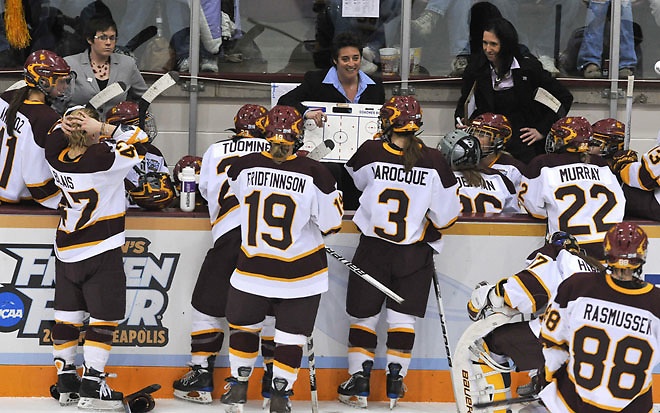
In 2010, Minnesota Duluth’s reign was coming to an end and Minnesota’s was just beginning. The Bulldogs won their fifth title to start the decade. The Gophers had just two NCAA national championships when the decade started. Clarkson emerged as a force to be reckoned with and become the only non-WCHA team to win a title.
To only look at the big picture, it looks like not much has changed in the women’s game. At the start of the decade, there were three teams that led the pack – Minnesota, Minnesota Duluth and Wisconsin. As we close it out, there’s still a focus on three programs, with Clarkson having replaced UMD in the top trio.
But looking closer shows that gaps are narrowing, overall quality of play has increased and things only look to be getting better.
Before 2010 just 13 teams had received the 56 NCAA bids that had been given out. Since then, that number has doubled. Programs that are now considered perennial contenders had barely made an impact before this decade started and schools that ruled the first ten years have struggled to regain that early success.
All of Cornell’s seven NCAA tournament appearances and four Frozen Four berths came in the 2010’s. Six of Boston College’s seven Frozen Four appearances happened in this decade. They made the NCAA tournament in eight of the ten years of the 2010’s.
Conversely, seven of St. Lawrence’s nine NCAA tournament berths came before 2010 and all five of their Frozen Four appearances happened before 2007. Dartmouth and New Hampshire were also post-season regulars from 2001-2009, but haven’t been able to find the same success in the 2010’s.
Three schools – Niagara, Wayne State and North Dakota – cut their women’s hockey programs this decade, but LIU, Merrimack, Lindenwood, RIT, Penn State and Holy Cross added division I programs and the advent of the NEWHA conference brings the current total number of teams competing for the championship to 41.
What we have seen is massive development in the middle tier of teams and talent. While the growth hasn’t yet manifested itself much in the way of new champions, that breakthrough feels much closer. The talent pool is much wider and deeper as hockey takes off in non-traditional markets and Canadian and international players take advantage of the education and development playing in the NCAA offers.
Players from Germany, Switzerland, Sweden, Finland, Czech Republic, Latvia, Russia, Austria, Italy, France, Norway, Denmark, Hungary and Japan bolster NCAA Division I rosters, as well as players from 31 US states and 10 Canadian provinces.
College teams are playing in places like San Jose, Nashville and Washington DC to showcase the high level of play and bring the concept of women’s college hockey to smaller and more non-traditional markets. Players from California, Arizona, Florida and Colorado are filling out rosters and proving that the East Coast, Midwest and Canada don’t have the market on top tier talent cornered.
That increased talent pool has helped close the gap between the top and bottom teams – elite squads may still be elite, but they aren’t untouchable. Coaches used to go to tournaments and showcases to recruit a single player, who’s play stood out far above her competition. Now, they say, the level of overall competitiveness has been raised and it’s far more difficult to pick out a single superstar player. Landing one of the best players in the country isn’t a make or break prospect, nor is it only reserved for a small handful of schools.
Top recruits aren’t only choosing from a small handful of universities. The USA team playing at the current IIHF U-18 World Championships has recruits committed to 13 different universities.
All that plays out on the ice, giving proof to the coach’s cliche that any team can win on any given day. Holy Cross’s first NCAA and Hockey East win – in fact their only win last season – came over no. 5 Northeastern. Brown won five games last year, but two of them were over no. 9 Colgate and no. 6 Cornell in one weekend.
This past decade has been one of transition for women’s hockey. We’ve yet to see how the improvement of players and teams will play out, but I don’t think we’re a long way from finding out. The days where a small group of teams dominates are dwindling as the expansion and growth of this decade have laid the foundation for upsets and unexpected champions.
The game continues to get faster, with better puck handling, stick work and movement. There’s less specialization as players are expected to have a 200-foot game. Forwards back check and block and defenders step up into the offense and play a major goal-scoring role. The finesse with which the game is played is as smooth as ever and there’s no reason to believe any of those things will do anything but continue to improve.
The 2010’s showed a glimpse of what Division I women’s college hockey players are capable of. In 2020 and beyond, expect that potential to reach fulfillment.


